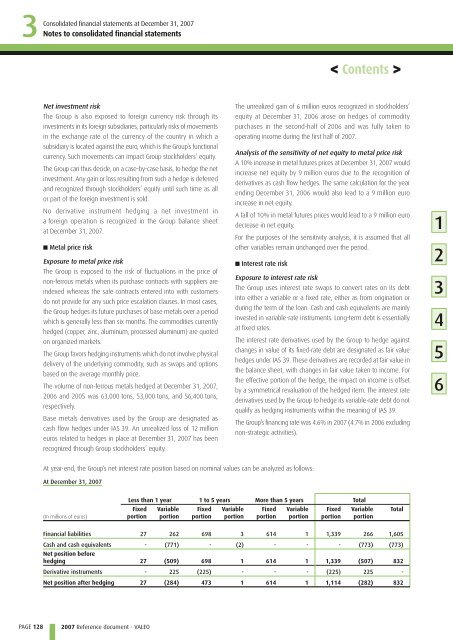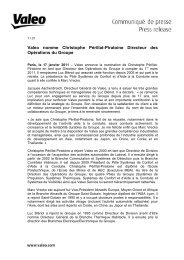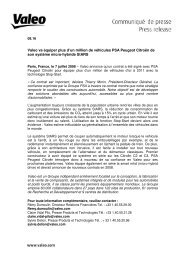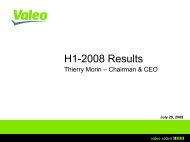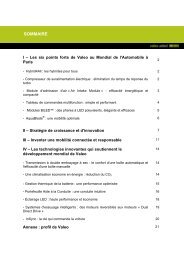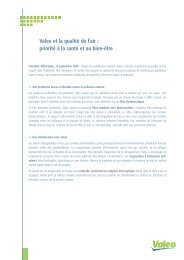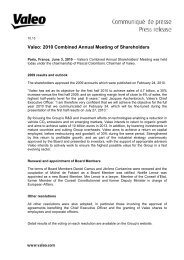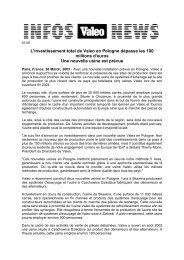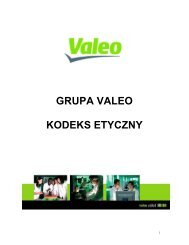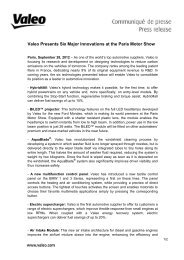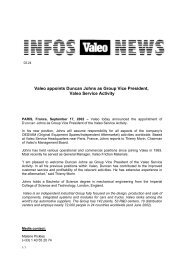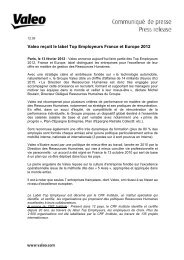2007 Reference document (PDF) - Valeo
2007 Reference document (PDF) - Valeo
2007 Reference document (PDF) - Valeo
You also want an ePaper? Increase the reach of your titles
YUMPU automatically turns print PDFs into web optimized ePapers that Google loves.
3 Consolidated<br />
PAGE 128<br />
fi nancial statements at December 31, <strong>2007</strong><br />
Notes to consolidated financial statements<br />
Net investment risk<br />
The Group is also exposed to foreign currency risk through its<br />
investments in its foreign subsidiaries, particularly risks of movements<br />
in the exchange rate of the currency of the country in which a<br />
subsidiary is located against the euro, which is the Group’s functional<br />
currency. Such movements can impact Group stockholders’ equity.<br />
The Group can thus decide, on a case-by-case basis, to hedge the net<br />
investment. Any gain or loss resulting from such a hedge is deferred<br />
and recognized through stockholders’ equity until such time as all<br />
or part of the foreign investment is sold.<br />
No derivative instrument hedging a net investment in<br />
a foreign operation is recognized in the Group balance sheet<br />
at December 31, <strong>2007</strong>.<br />
■ Metal price risk<br />
Exposure to metal price risk<br />
The Group is exposed to the risk of fluctuations in the price of<br />
non-ferrous metals when its purchase contracts with suppliers are<br />
indexed whereas the sale contracts entered into with customers<br />
do not provide for any such price escalation clauses. In most cases,<br />
the Group hedges its future purchases of base metals over a period<br />
which is generally less than six months. The commodities currently<br />
hedged (copper, zinc, aluminum, processed aluminum) are quoted<br />
on organized markets.<br />
The Group favors hedging instruments which do not involve physical<br />
delivery of the underlying commodity, such as swaps and options<br />
based on the average monthly price.<br />
The volume of non-ferrous metals hedged at December 31, <strong>2007</strong>,<br />
2006 and 2005 was 63,000 tons, 53,000 tons, and 56,400 tons,<br />
respectively.<br />
Base metals derivatives used by the Group are designated as<br />
cash flow hedges under IAS 39. An unrealized loss of 12 million<br />
euros related to hedges in place at December 31, <strong>2007</strong> has been<br />
recognized through Group stockholders’ equity.<br />
<strong>2007</strong> <strong>Reference</strong> <strong>document</strong> - VALEO<br />
The unrealized gain of 6 million euros recognized in stockholders’<br />
equity at December 31, 2006 arose on hedges of commodity<br />
purchases in the second-half of 2006 and was fully taken to<br />
operating income during the first half of <strong>2007</strong>.<br />
Analysis of the sensitivity of net equity to metal price risk<br />
A 10% increase in metal futures prices at December 31, <strong>2007</strong> would<br />
increase net equity by 9 million euros due to the recognition of<br />
derivatives as cash flow hedges. The same calculation for the year<br />
ending December 31, 2006 would also lead to a 9 million euro<br />
increase in net equity.<br />
A fall of 10% in metal futures prices would lead to a 9 million euro<br />
decrease in net equity.<br />
For the purposes of the sensitivity analysis, it is assumed that all<br />
other variables remain unchanged over the period.<br />
■ Interest rate risk<br />
At year-end, the Group’s net interest rate position based on nominal values can be analyzed as follows:<br />
At December 31, <strong>2007</strong><br />
(In millions of euros)<br />
Exposure to interest rate risk<br />
The Group uses interest rate swaps to convert rates on its debt<br />
into either a variable or a fixed rate, either as from origination or<br />
during the term of the loan. Cash and cash equivalents are mainly<br />
invested in variable-rate instruments. Long-term debt is essentially<br />
at fixed rates.<br />
The interest rate derivatives used by the Group to hedge against<br />
changes in value of its fixed-rate debt are designated as fair value<br />
hedges under IAS 39. These derivatives are recorded at fair value in<br />
the balance sheet, with changes in fair value taken to income. For<br />
the effective portion of the hedge, the impact on income is offset<br />
by a symmetrical revaluation of the hedged item. The interest rate<br />
derivatives used by the Group to hedge its variable-rate debt do not<br />
qualify as hedging instruments within the meaning of IAS 39.<br />
The Group’s financing rate was 4.6% in <strong>2007</strong> (4.7% in 2006 excluding<br />
non-strategic activities).<br />
Less than 1 year 1 to 5 years More than 5 years Total<br />
Fixed<br />
portion<br />
Variable<br />
portion<br />
Fixed<br />
portion<br />
Variable<br />
portion<br />
Fixed<br />
portion<br />
Variable<br />
portion<br />
< Contents ><br />
Fixed<br />
portion<br />
Variable<br />
portion<br />
Financial liabilities 27 262 698 3 614 1 1,339 266 1,605<br />
Cash and cash equivalents<br />
Net position before<br />
- (771) - (2) - - - (773) (773)<br />
hedging 27 (509) 698 1 614 1 1,339 (507) 832<br />
Derivative instruments - 225 (225) - - - (225) 225 -<br />
Net position after hedging 27 (284) 473 1 614 1 1,114 (282) 832<br />
Total<br />
1<br />
2<br />
3<br />
4<br />
5<br />
6


